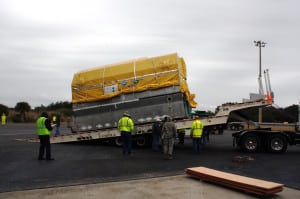
A GPS 2F Satellite offloaded from a C-17 aircraft at Cape Canaveral AFS, Fla. on Feb. 12, 2010. Photo: Air Force Space Command
[Via Satellite 12-12-2014] The cost of storing satellites for various United States Department of Defense (DOD) programs is expected to surpass $200 million over the course of the next five years, according to a study from the Government Accountability Office (GAO). The agency found DOD spent more than $130 million on storing satellites during the past five years — excluding three satellites that underwent upgrades — and that the reasons for the cost of storage are not fully understood.
GAO evaluated eight different DOD satellite programs, such as the Advanced Extremely High Frequency (AEHF) satellite system, the Global Positioning System 2-F, and the Wideband Global Satcom (WGS) system during a performance audit from January to December 2014. From this evaluation, the agency found that DOD typically seeks to launch satellites as soon as they are ready, but changes in procurement methods are making storage more of a priority. Block buys of satellites, while praised for their efficiency as a procurement method, necessitate storage as satellites are produced quicker than they are needed for launch. GAO noted that, while storage is being considered or even included in production costs, no specific policies exist on how and when to contract for satellite storage.
Based on the programs assessed, the total costs for storing a single satellite can run the gamut from $40,000 to an expected $120 million. DOD attributed the majority of storage costs to personnel needed for maintenance and testing, along with preparations for launching. But GAO noted that granular information was not available to accurately gauge these costs.
“Satellite program offices were not able to provide storage cost data at a detailed level — such as the number of personnel and costs for each type of storage activity — since such data are not collected at that level. A detailed breakdown of storage costs could provide insights into the cost variations experienced across programs and an identification of the cost drivers that could provide contracting officers an advantage in negotiations to potentially obtain better storage rates,” GAO wrote.
These satellites require routine checks to address the issues that come from storage, such as lubricants settling in rotation wheel assembles and batteries becoming partially depleted. DOD said storage does not typically have any major effects on a satellite’s operational lifetime. Testing is done to ensure satellites remain in good health.
GAO queried other U.S. agencies that often procure satellites to compare their practices to DOD. NASA, the National Oceanographic and Atmospheric Administration (NOAA) and the National Reconnaissance Office (NRO) all said they seek to launch satellites immediately following completion. NRO said it stores some satellites on the ground as part of the planned production of multiple satellites. NOAA prefers to store back-up satellites in orbit to quickly react to any satellite failures that would otherwise result in a capability gap. The risks for in-orbit spares are different, stemming mainly from the harsh environment of space.
Federal Acquisition Regulation (FAR) demands that contracting officers have enough information to determine if the prices they are getting are fair and reasonable. GAO, through contacting the Defense Contract Audit Agency (DCAA) and the Defense Contract Management Agency (DCMA), found that neither organization heard from DOD on reviewing actual or proposed storage costs for any of the eight satellite programs evaluated. GAO informed DOD that having information from these agencies could provide a better understanding of whether or not storage costs are reasonable, especially as decision making on this topic evolves.
“DOD has limited insight into the components of the satellite storage costs it has incurred. As a result, DOD may be missing opportunities to better inform its contract negotiations on the costs of satellite storage since it has not cultivated detailed cost data and has not involved DCAA or DCMA in assessing the reasonableness of contractors’ actual or proposed costs,” GAO wrote.
According to GAO, satellite program offices have differing approaches to using and contracting satellite storage, such as contracting long-term storage into block buys, or negotiating on an as-needed basis. The agency recommended the Secretary of Defense step in to provide guidance on satellite storage. More specifically, GAO suggested he help determine when and how to use storage in the process of acquiring satellites, and that he establish methods of collecting data on contractor storage cost proposals. GAO said DOD concurred with the agency’s recommendations.
The post Satellite Storage Costs to Exceed $200 Million for DOD appeared first on Via Satellite.